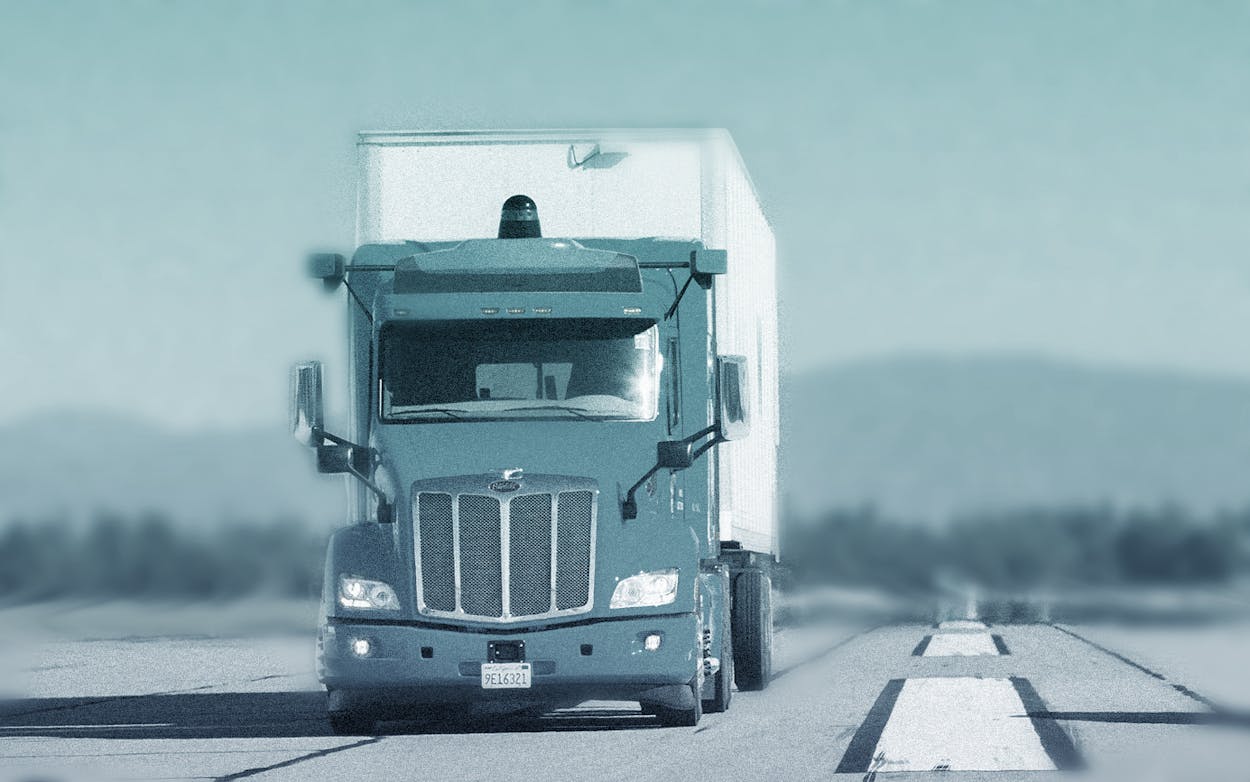Over the last few years, Waymo—the self-driving technology company that’s part of Alphabet, the Google parent company—has launched fleets of autonomous big rigs and minivans in California, Arizona, and Georgia. Last week, the company revealed plans for a vast new territorial expansion into Texas and New Mexico. Eager to identify promising commercial routes, Waymo says it’s been lured to Texas because of the state’s high freight volume, according to a statement provided by the company.
Waymo says it plans to start by using its autonomous Chrysler Pacifica minivans equipped with a suite of sophisticated sensors to create detailed maps of interstates 10, 20, and 45. At some later date, the company will deploy much larger semitrailer trucks with trained drivers in the cabs to take control if needed. The self-driving semis will rely on information from the maps, such as speed limits and road conditions, to drive on major interstates. Waymo didn’t offer a timeline for the rollout of the trucks.
Promoters of autonomous trucks argue that they’ll increase efficiency, lower costs, and remove human error from heavily trafficked roadways, making everyone safer. It’s a lofty vision, one that tends to ignore some stark predictions: over the next 25 years, some experts estimate, autonomous technology could replace nearly 300,000 long-haul truck drivers around the nation.
In a vast state with nearly 65,000 trucking companies, according to the Texas Trucking Association, most of them small and locally owned, it’s not unreasonable to assume that many of the workers who could lose their jobs reside in Texas.
Truck drivers are already pushing back. The International Brotherhood of Teamsters, a union representing 1.4 million members, about 600,000 of whom work in transportation, says automated trucks rely on unproven technology that places public safety at risk. On the union’s website, a news release asserts that the public finds the idea of riding in a driverless vehicle “scary as hell.” Another news release warns that robots could turn trucks hauling hazardous waste into “driverless bombs.”
Reached by phone, Brian Ahearn, president and business manager of Teamsters Local 577 in Amarillo, said his union was closely watching Waymo’s incursion into Texas and was concerned about job losses.
“If the state doesn’t intervene I think we could see big job losses in the next ten years and maybe sooner because this technology is moving along pretty quickly,” Ahearn said.
John Esparza, CEO and president of the Texas Trucking Association, which represents more than eight hundred trucking companies around the state, said he’s looking forward to the arrival of robotically piloted big rigs.
“The Department of Public Safety will tell you distracted drivers are the biggest killer of drivers on our highways today and—once you deploy this technology that takes error out of human hands—you’ll start seeing some real change,” said Esparza, who served as a policy adviser to Governor Rick Perry and was later appointed to the Texas Tech University System Board of Regents by Perry. He also said that an experienced truck driver with a clean driving record is a “hot commodity.”
“I don’t see a time in the near future, or even when my grandkids are grown, that there won’t be a need for truck drivers,” he said.
Alejandra Cid, a management consultant for AAA CDL School, a 21-year-old truck driving school located in Houston, agrees, telling KHOU she doesn’t worry about autonomous trucks replacing drivers. “The demand for drivers is so high, regardless of whether or not you’re actually controlling the wheel,” she said.
But Steve Viscelli, a sociologist who spent several months as a truck driver before writing his book The Big Rig: Trucking and the Decline of the American Dream, argues that focusing on the number of available trucking jobs in the future misses an important point. Most at risk, he told the Wall Street Journal in 2018, are long-haul truckers who move cargo over vast distances but perform few other tasks, as well as drivers with higher-paying jobs transporting goods for package delivery companies.
“The risk of autonomous trucks is not that there won’t be enough jobs for American truckers, it’s that there won’t be enough good jobs,” Viscelli wrote in a 2018 report about the impact of autonomous trucking on human drivers.
Proponents of self-driving trucks also promote them as a safer alternative to human-driven vehicles. There are no publicly available reports of cash for crash rings operating in Texas, but national statistics show that large trucks and buses were involved in thousands of crashes each year. In 2017—the most recent year of available U.S. Department of Transportation data—4,889 large trucks and buses were involved in fatal crashes, a 9 percent increase from 2016.
Self-driving vehicle evangelists envision an accident-free world, but their hopeful message can ignore the dangers created by the pursuit of that vision. Waymo’s minivans have been involved in numerous wrecks. In some cases, Waymo’s human safety drivers or other motorists have been at fault, but there appear to be no reports of crashes resulting directly from failures in the company’s self-driving technology.
Outside of Silicon Valley, where insiders are known to quietly disavow the products they engineer, there is a tendency to feel grateful when one of their corporate heavyweights selects your province for testing its latest toy, be it a ride-hailing vehicle or an electric scooter. But Kara Deniz, a spokesperson for the Teamsters, said the public should be skeptical that autonomous technology arriving in their state will result in safer driving conditions, largely because of where that notion originates.
“The tech industry has a very clear profit-driven business model that has invested millions of dollars in making sure this technology is developed at a very fast pace,” Deniz said. “This is something that should be done deliberately, but public roads—and the public itself—[are] being used as guinea pigs to implement the industry’s new technology.”
- More About:
- Politics & Policy








